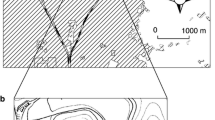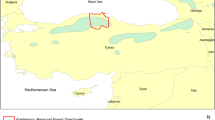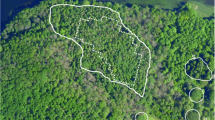Abstract
The dynamics and regeneration probabilities ofQuercus acuta, Q. gilva, Q. salicina, andQ. sessilifolia were studied in a 0.48 ha plot in an old-growth evergreen broad-leaved forest, Kagoshima prefecture, southwestern Japan. The canopy was well closed and had only one small gap. Seventeen tree species occurred in the canopy. The fourQuercus species ranked second to fifth in basal area. Excluding the trees originated from sprouts,Q. acuta and Q. gilva lacked trees at the subcanopy layer, andQ. salicina andQ. sessilifolia had some trees at the same layer. For eachQuercus species, the amount of fallen acorns fluctuated from year to year. The number of current year seedlings was positively correlated with the number of fallen acorns in the previous year. A disproportion between the spatial distribution of fallen acorns and that of established seedlings has been shown. The establishment of seedlings was frequently observed where no acorns had fallen in the previous year. Saplings of four species survived for several years and formed sapling banks under the closed canopy. During the three years of the study, the mortality ofQ. salicina andQ. sessilifolia saplings was lower than that ofQ. acuta andQ. gilva. However, the differences in the average annual height growth of saplings between four species were not significant, and the most of them did not grow much. These results suggest that the saplings of the fourQuercus, especiallyQ. gilva andQ. acuta, have no chance to recruit to the canopy or subcanopy layer within a closed stand, and that some changes in the environment caused by gap formation are required for their recruitment.
Similar content being viewed by others
Abbreviations
- ha:
-
hectare (=10,000 m2)
References
Augspurger, C.K. 1983. Offspring recruitment around tropical trees: changes in cohort distance with time. Oikos40: 189–196.
Borchert, M.I., Davis, F.W., Michaelsen, J. andOyler, L.D. 1989. Interactions of factors affecting seedling recruitment of blue oak (Quercus douglasii) in California. Ecology70: 389–404.
Bran, D., Lobraux, O., Maistre, M., Perret P. andRomane, F. 1990. Germination ofQuercus ilex andQ. pubescens in aQ. ilex coppice. Vegetatio87: 45–50.
Briggs, J.M. andSmith K.G. 1989. Influence of habitat on acorn selection byPeromyscus leucopus. J. Mamm.70: 35–43.
Clark, D.A. andClark D.B. 1984. Spacing dynamics of a tropical rain forest tree: Evaluation of the Janzen-Connnel model. Am. Nat.124: 769–788.
Forest Soil Division 1976. Classification of Forest Soil in Japan (1975). Bull. Gov. For. Exp. Sta.280: 1–28.
Hiroki, S. andMatsubara, T. 1982. Ecological studies on the plants of Fagaceae. III. Comparative studies on the seed and seedling stages. Jap. J. Ecol.32: 227–240. (in Japanese with English summery)
Howe, H.F. 1986. Seed dispersal by fruit-eating birds and mammals.In D.R. Murray, ed., Seed dispersal. Academic Press, London, pp. 123–189.
Howe, H.F., Schupp, E.W. andWestley, L.C. 1985. Early consequences of seed dispersal for a Neotropical tree. Ecology.66: 781–791.
Iwao, S. 1972. Application of them *-m method to the analysis of spatial patterns by changing the quadrat size. Res. Popul. Ecol.14: 97–128.
Iwao, S. 1977. Analysis of spatial association between two species based on the interspecies mean crowding. Res. Popul. Ecol.18: 243–260.
Kanazawa, Y. andNishikata, S. 1976. Disappearance of acorns from the floor inQuercus crispula forests. J. Jap. For. Soc.58: 52–56.
Kobayashi, Y. andMidorikawa, T. 1959. Dendrological studies of the Japanese Fagaceae. On the ripening term of the fruits ofQuercus, Castanopsis andPasania. Bul. Gov. For. Sta.117: 11–55 (in Japanese with English summary)
Matsubara, T. andHiroki, S. 1989. Ecological studies on the plants of Fagaceae. V. Growth in the sapling stage and minimal participation of reserve materials in the formation of annual new shoots of theQuercus glauca Thunb. Ecol. Res.4: 175–186. (in Japanese with English summary)
Miyawaki, A. 1981. Vegetation of Japan vol. 2 Kyushu. Shibundo, Tokyo. (in Japanese)
Naka, K. 1982. Community dynamics of evergreen broadleaf forests in southwestern Japan. I. Wind damaged trees and canopy gaps in an evergreen oak forest. Bot. Mag. Tokyo95: 385–399.
Naka, K. andYoda, K. 1984. Community dynamics of evergreen broadleaf forests in southwestern Japan. II. Species composition and density of seeds buried in the soil of a climax evergreen oak forest. Bot. Mag. Tokyo97: 61–79.
Numata, M., Miyawaki, A. andItow, S. 1972. Natural and semi-natural vegetation in Japan. Blumea20. 436–496.
Omura, M., Miyata, I. andHosokawa, T. 1978. Vegetation types and association analysis.In T. Kira, Y. Ono and T. Hosokawa, eds. Biological production in a warm-temperate evergreen oak forest of Japan. JIBP Synthesis 18. University of Tokyo Press, Tokyo, pp. 8–21.
Ono, Y. andSuganuma, T. 1991. A comparison of seed germination and initial growth of current seedlings of three species ofQuercus. Jpn. J. Ecol.41: 93–99. (in Japanese with English summary)
Price, M.V. andJenkins, S.H. 1986. Rodents as seed consumers and dispersers.In D.R. Murray, ed., Seed dispersal, Academic Press, London, pp. 191–235.
Shaw, M.W. 1968a. Factors affecting the natural regeneration of sessile oak (Quercus petraea) in North Wales. I. A preliminary study of acorn production, viability and losses. J. Ecol.56: 565–583.
Shaw, M.W. 1968b. Factors affecting the natural regeneration of sessile oak (Quercus petraea) in North Wales. II. Acorn losses and germination under field conditions. J. Ecol.56: 647–660.
Suzuki, T. 1960. Forest suite for Japanese oak species,Cyclobalanopsis gilva Oerst. Jap. J. For. Environ.8: 1–6 (in Japanese with German summery)
Takenaka, A. 1986. Comparative ecophysiology of two representativeQuercus species appearing in different stages of succession. Ecol. Res.1: 129–140.
Tanouchi, H. 1990. Light conditions in the understory of aCastanopsis cuspidata coppice forest and the growth of young tree (Quercus glauca, Quercus gilva andCastanopsis cuspidata) planted there in Differences of shade tolerance and positions in the sere-. J. Jpn. For. Soc.72: 435–440. (in Japanese with English summary)
Tripathi, R.S. andKhan, M.L. 1990. Effects of seed weight and microsite characteristics on germination and seedling fitness in two species ofQuercus in a subtropical wet hill forest. Oikos57: 289–296.
Yamamoto, S. 1992. Gap characteristics and gap regeneration in primary evergreen broad-leaved forests of western Japan. Bot. Mag. Tokyo105: 29–45.
Yamashita, T. andHayashi, I. 1987. An analytical study on the successional process fromPinus densiflora toQuercus myrsinaefolia stands in Tsukuba, Ibaraki prefecture. Bull. Tsukuba Univ. For.3 59–82 (in Japanese with English summery)
Author information
Authors and Affiliations
Rights and permissions
About this article
Cite this article
Tanouchi, H., Sato, T. & Takeshita, K. Comparative studies on acorn and seedling dynamics of fourQuercus species in an evergreen broad-leaved forest. J. Plant Res. 107, 153–159 (1994). https://doi.org/10.1007/BF02346011
Received:
Accepted:
Issue Date:
DOI: https://doi.org/10.1007/BF02346011




